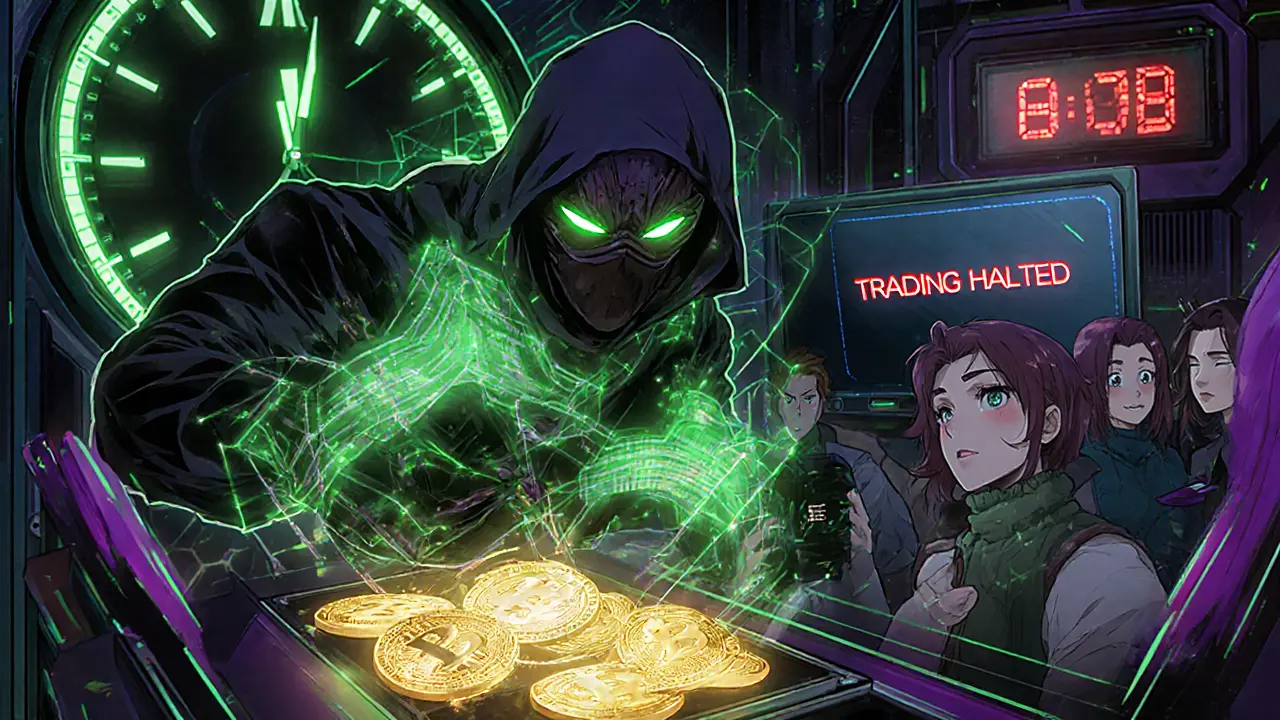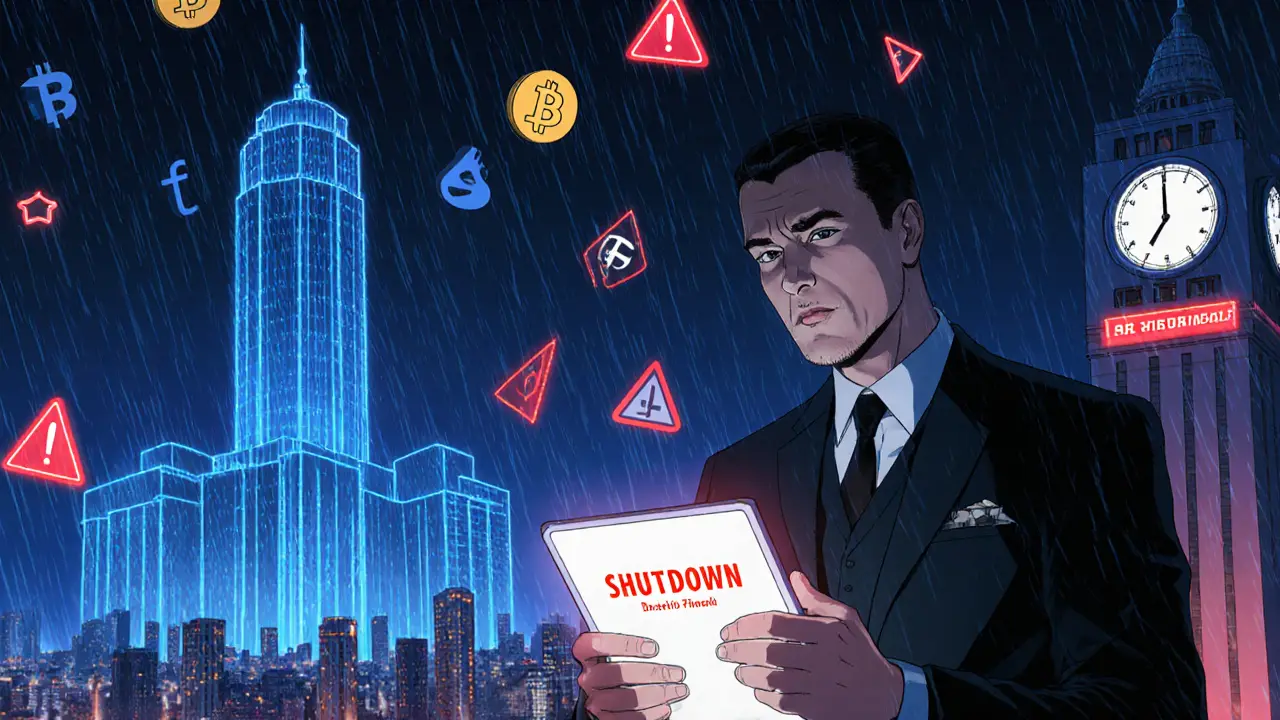Iranian Crypto Restrictions Timeline (2025)
Key Insights
- January 2025: Shutdown of all rial payment gateways for crypto exchanges
- June 18, 2025: Trading-hour curfew imposed after Nobitex hack
- July 2, 2025: Tether froze 42 Iranian-linked wallets
- August 2025: Capital-gains tax introduced on crypto trading
- September 2025: OFAC sanctions hit shadow-banking facilitators
When the Iranian government started tightening the reins on digital money in 2025, everyday users felt the shock almost instantly. Iranian crypto exchange restrictions refer to the series of legal, technical, and enforcement measures introduced by Tehran that limit how citizens can buy, sell, or move cryptocurrencies. The story isn’t just about a few blocked websites - it’s a cascade of policies, hacks, and international sanctions that together reshaped the country’s crypto landscape within months.
Key Takeaways
- January 2025: the Central Bank of Iran (CBI) ordered the shutdown of all rial payment gateways for crypto exchanges.
- June 18, 2025: a massive hack on Nobitex Iran’s largest crypto exchange serving over 11million users triggered a 14‑hour daily trading window restriction.
- July 2, 2025: Tether froze 42 Iranian‑linked wallets, pushing users toward DAI on the Polygon network.
- August 2025: Iran introduced a capital‑gains tax on crypto trading, treating digital assets like gold or real‑estate.
- September 2025: OFAC sanctions hit shadow‑banking facilitators, further choking cross‑border crypto flows.
Who Controls Crypto in Iran?
The Central Bank of Iran (CBI) the nation’s monetary authority responsible for licensing and supervising financial institutions now holds absolute power over every crypto‑related activity. Mining stays legal, but using digital assets for payments is outright banned. Operators must obtain a license, submit transparent financial reports, and obey strict trading‑hour limits.
Timeline of Major Restrictions in 2025
| Month | Restriction | Scope | Immediate Impact |
|---|---|---|---|
| January | Rial payment gateway shutdown | All domestic exchanges | Fiat‑to‑crypto deposits halted; users forced to rely on peer‑to‑peer methods. |
| June 18 | Trading‑hour ban (8PM-10AM) | All domestic platforms | Liquidity squeezed into a 14‑hour window; price volatility spiked. |
| July 2 | Tether wallet freeze | 42 addresses linked to Iranian users | USDT holdings immobilized; shift toward DAI on Polygon. |
| August | Capital‑gains tax on crypto trades | All crypto traders | Effective tax rate 15%; reporting obligations added. |
| September | OFAC sanctions on crypto‑facilitators | Shadow‑banking network & associated wallets | International liquidity further restricted; compliance checks intensified. |
The Nobitex Hack: A Catalyst for New Rules
On June18, 2025, Nobitex the nation’s biggest crypto exchange, handling billions of dollars in daily volume suffered a politically motivated breach that stole more than $90million. The hack did more than drain wallets - it forced Tehran to impose the first ever trading‑hour curfew, citing security concerns. Users now have to concentrate all buying and selling between 10AM and 8PM local time, a move that amplified price swings and pushed many to look for off‑shore alternatives.

International Enforcement: Tether’s Freeze and OFAC Sanctions
July2 marked the largest freeze in Tether’s history: 42 wallets tied to Iranian activity were locked, many of which had links to the Islamic Revolutionary Guard Corps (IRGC) Iran’s elite military force often implicated in sanctions‑evasion schemes. The freeze forced a rapid migration to DAI a decentralized stablecoin pegged to the US dollar on the Polygon network a layer‑2 scaling solution for Ethereum offering low fees. The shift demonstrated the community’s agility but also highlighted the fragility of relying on a single stablecoin.
Later in September, the U.S. Treasury Department the federal agency overseeing fiscal policy and sanctions via its Office of Foreign Assets Control (OFAC) the body that enforces economic and trade sanctions designated a $600million Iranian shadow‑banking network. Addresses on Ethereum and Tron linked to facilitator Arash Estaki Alivand were blocked, further choking the flow of illicit oil revenue.
Taxation Changes: Capital Gains on Crypto
August 2025 brought the Law on Taxation of Speculation and Profiteering. For the first time, any profit from buying and selling crypto is taxed at a flat 15% rate, similar to gold or foreign‑exchange gains. The law requires traders to file monthly declarations, keep transaction logs, and retain proof of cost basis. While the tax aims to boost state revenue, many users view it as another barrier that pushes activity underground.
How Users Are Adapting
Despite the crackdown, Iranians still need ways to protect wealth from soaring inflation. The community’s response can be summed up in three trends:
- Peer‑to‑peer (P2P) trading: With payment gateways blocked, users rely on messenger apps and local cash meet‑ups to exchange rial for crypto.
- Stablecoin diversification: After the Tether freeze, many swapped USDT for DAI on Polygon, later moving to other low‑fee assets like USDC on Solana.
- Off‑shore wallets and VPNs: To bypass domestic restrictions, tech‑savvy users employ VPNs and foreign exchange services to access global platforms such as Binance or Kraken, albeit at higher risk.
These workarounds keep crypto flowing, but they also raise the profile of illicit activity, feeding the regulators’ justification for stricter measures.
Expert Views on the Future Outlook
Blockchain‑intelligence firms Elliptic and TRM Labs both note that Iran’s crypto sector is entering a “cat‑and‑mouse” phase. Elliptic’s analysis describes Nobitex as “critical infrastructure for sanctions evasion,” while TRM reports an 11% dip in inbound crypto volume during the first half of 2025. Both agree that the government will keep tightening civilian access while preserving a state‑level crypto channel for international transactions.

What This Means for Iranian Citizens Today
If you’re an Iranian trying to navigate the current environment, here are the practical takeaways:
- Do not rely on USDT for long‑term storage; shift to DAI or diversified stablecoins.
- Plan all trading activity within the 10AM‑8PM window to avoid forced shutdowns.
- Keep detailed transaction records for tax reporting; failure can trigger fines or criminal probes.
- Consider using reputable VPN services if you must access foreign exchanges, but understand the legal risk.
- Stay alert to OFAC‑related news; addresses flagged by U.S. sanctions can be frozen without warning.
Quick Checklist for Safe Crypto Use in Iran (2025)
| Action | Why It Matters |
|---|---|
| Use DAI on Polygon | Less likely to be frozen by Tether |
| Trade only between 10AM‑8PM | Avoid platform shutdowns |
| Maintain CSV transaction logs | Comply with August tax law |
| Secure VPN with no‑log policy | Reduce traceability when accessing foreign sites |
| Follow official CBI licensing updates | Know which platforms remain legal |
Frequently Asked Questions
Can I still buy Bitcoin in Iran after the 2025 restrictions?
Yes, but only through peer‑to‑peer channels or licensed domestic exchanges that operate within the 10AM‑8PM window. Direct fiat‑to‑crypto gateways are closed.
Is holding USDT illegal for Iranian citizens?
Holding USDT isn’t illegal, but the July 2025 freeze means large balances can be locked without recourse. Switching to DAI or other stablecoins is safer.
How does the new capital‑gains tax work?
Profits from crypto trades are taxed at a flat 15% rate. Traders must report monthly gains, retain transaction receipts, and pay the tax through the Iranian tax portal.
What should I do if my wallet gets frozen by OFAC?
Once an address is sanctioned, the assets are effectively seized. The only realistic option is to move any remaining funds to a non‑sanctioned address before the freeze takes effect.
Are crypto mining operations still allowed?
Mining remains legal and even government‑supported because it helps offset electricity costs. However, miners must register with the CBI and disclose power usage.
Next Steps for Readers
Whether you’re a casual trader, a miner, or a fintech entrepreneur, the safest path forward is to stay informed and adapt quickly. Keep an eye on CBI announcements, follow reputable local crypto influencers for real‑time workarounds, and consider diversifying your holdings across multiple blockchains to mitigate the risk of a single‑point freeze.
In short, Iran’s 2025 crypto crackdown is a moving target. The more you understand the timeline, the players, and the technical workarounds, the better you’ll be able to protect your assets and keep your transactions flowing.


Post Comments (20)
Iran's crypto crackdown in 2025 certainly feels like a storm, but it also offers a chance for the community to show resilience and ingenuity. The shutdown of rial payment gateways forced many users onto peer‑to‑peer channels, which, while less convenient, has revived a sense of grassroots collaboration. The trading‑hour curfew imposed after the Nobitex hack compressed liquidity into a narrower window, leading to heightened volatility that sharp traders can actually profit from. Meanwhile, the Tether wallet freeze highlighted the importance of diversifying stablecoins, prompting a swift migration to DAI on Polygon and other alternatives. The newly introduced 15% capital‑gains tax may seem burdensome, yet it also brings crypto trading into the formal tax net, potentially legitimizing the sector in the eyes of regulators. OFAC sanctions against shadow‑banking facilitators have added another layer of complexity, but they also underline the geopolitical stakes tied to Iranian crypto activity. Miners remain legal, which keeps the network sufficiently secured, and the government's support for mining could act as a stabilizing factor. Users have adapted by employing VPNs, offshore wallets, and off‑shore exchanges, showcasing a remarkable capacity for technical adaptation. The community's rapid response demonstrates that restrictions can never fully stifle a determined user base. As more assets move to decentralized platforms, the risk of single‑point failures diminishes, fostering a more robust ecosystem. The experience also provides valuable lessons for other countries considering similar crackdowns. Although the short‑term pain is undeniable, the long‑term gains in user education and risk management are significant. The narrative is not just about loss, but about transformation and strategic evolution. By staying informed and agile, Iranian crypto enthusiasts can continue to protect their wealth against inflation and sanctions. The timeline of events serves as a roadmap for future regulatory battles worldwide. In the end, restriction breeds innovation, and innovation fuels progress. Let us all stay vigilant, share knowledge, and support each other through these challenging times.
Indeed, the recent measures, while severe, open doors for creative solutions, and users, by collaborating, can mitigate many of the hardships, especially when leveraging peer‑to‑peer networks, which, despite their informal nature, provide a resilient backbone for transactions, while the curfew, oddly, concentrates market activity, potentially leading to more predictable price patterns, and the Tether freeze, as unanticipated as it was, underscores the necessity of multi‑stablecoin strategies, such as DAI, USDC, and even newer layer‑2 options, all of which, when combined, create a diversified safety net for holdings, and the capital‑gains tax, while an added cost, also encourages better record‑keeping, thereby fostering transparency, and finally, the OFAC sanctions, though targeting shadow‑banking, remind us of the global reach of compliance, urging us to stay vigilant, diversified, and adaptive.
The Iranian Central Bank's decision to shut down rial gateways effectively shifted the on‑ramp landscape to peer‑to‑peer platforms, which now dominate daily volume. Traders must now schedule activities within the 10 AM–8 PM window to avoid forced platform shutdowns. The Tether freeze illustrates the risk of over‑reliance on a single stablecoin; migrating to DAI on Polygon considerably reduces exposure to such freezes. The introduced 15% capital‑gains tax aligns crypto with traditional assets, necessitating meticulous record‑keeping for compliance. OFAC's sanctions on shadow‑banking networks further restrict cross‑border liquidity, prompting increased use of VPNs to access international exchanges. Despite these constraints, mining operations remain legal, offering a viable avenue for participation in the ecosystem. Users continue to adapt by employing diversified stablecoins, offshore wallets, and careful tax reporting to navigate the evolving regulatory environment.
It feels like the government is watching everything we do, and they probably have a secret plan behind every rule they make. The payment gateway ban pushed us all to meet in hidden places, and the trading curfew makes the market act weird. We should stay alert and keep our info safe.
Good luck navigating the new rules, everyone.
From a technical standpoint, the Tether freeze forced a rapid pivot to ERC‑20 DAI on Polygon, leveraging its low‑gas environment and cross‑chain bridges to maintain liquidity. Moreover, the imposition of a 15% capital‑gains tax necessitates integration of automated accounting bots that parse on‑chain transaction data, compute cost‑basis, and generate CSV reports for IR tax portals. The trading‑hour restriction, while ostensibly a security measure, actually creates a liquidity compression effect, which can be modeled using order‑book depth curves to anticipate price spikes. Users should also consider multi‑signature vaults to safeguard assets against potential future freezes, and employ decentralized identity (DID) solutions to preserve privacy while complying with KYC mandates on licensed platforms.
The crackdown is clearly a power move, and it's causing real damage to legitimate traders who just want to protect their savings. The tax and curfew feel punitive, and the freeze shows how vulnerable centralized stablecoins are. It's a worrying trend.
Oh great, another set of rules to make life easier-said no one ever. Apparently the authorities think freezing wallets and taxing trades will solve inflation, while we’re left figuring out how to move a few dollars without getting blocked. Sarcasm aside, it's a testament to how badly they understand crypto.
i feel for everyone dealing with these changes, it’s hard to keep up and not get scammed, stay safe and keep checking reliable sources for updates.
Esteemed community members, the recent legislative measures introduced by the Central Bank of Iran constitute a pivotal juncture in the nation’s financial architecture. It is incumbent upon us to methodically assess the ramifications of the rial gateway cessation, which compels a transition toward decentralized peer‑to‑peer mechanisms. The imposition of a fourteen‑hour trading window, engendered by the Nobitex incident, necessitates a recalibration of liquidity management strategies. Furthermore, the Tether imposition of wallet freezes underscores the imperative for diversification across multiple stablecoins, notably DAI on the Polygon network, to mitigate custodial risk. The newly instituted capital‑gains tax of fifteen percent mandates rigorous accounting practices, including the preservation of transaction ledgers and the timely submission of declarations via the national tax portal. Lastly, the OFAC sanctions targeting shadow‑banking conduits accentuate the need for vigilant compliance protocols, particularly when engaging with cross‑border exchanges. By embracing these adaptive measures, we safeguard both individual wealth and the broader integrity of Iran’s evolving digital asset ecosystem.
We must remember that adhering to these regulations is a moral duty; ignoring them only fuels illicit activity.
It is unacceptable that the government imposes punitive taxes and freezes without clear justification; such actions erode public trust and must be challenged.
One could argue that these restrictions are merely a pretext for deeper control, yet perhaps the real lesson lies in how quickly technology can adapt to circumvent attempts at suppression, which, in a curious twist, showcases the resilience of decentralized finance despite concerted regulatory pressure.
It’s tough to see so many changes at once, but staying connected with the community and sharing reliable information can make the transition smoother for everyone.
Wow, the new rules are intense, but we’ve got this! By collaborating, using VPNs responsibly, and diversifying our stablecoins, we’ll stay ahead of the curve, and the community’s resilience will shine brighter than ever! Let’s keep the momentum going!
Alright, so the crackdown means we’re forced into the shadows, but hey, that’s where the real tech magic happens-think of all the clever workarounds, secret meet‑ups, and rainbow‑colored crypto memes we’ll be sharing as we outsmart the system!
Stay safe, stay informed, and keep your crypto secure.
Remember, every challenge is an opportunity to grow; focus on solid risk management, keep your records tidy, and support each other as we navigate these new regulations together.
Colleagues, the recent regulatory developments demand a structured response: prioritize diversification of stablecoins, implement systematic tax reporting mechanisms, and maintain rigorous compliance with OFAC directives, thereby ensuring both operational continuity and legal conformity.
These draconian measures are an affront to any rational investor; the government’s heavy‑handed approach only proves they’re terrified of losing control over capital flows.